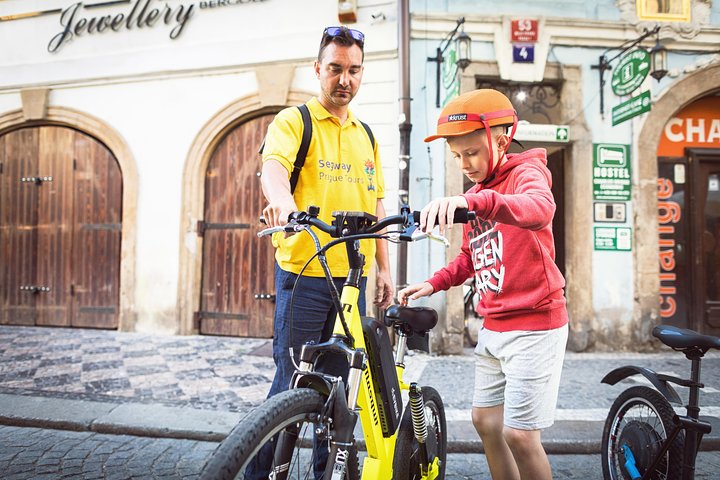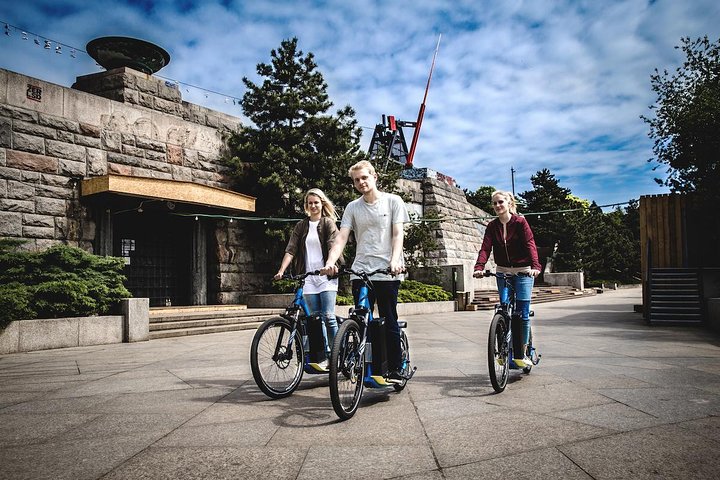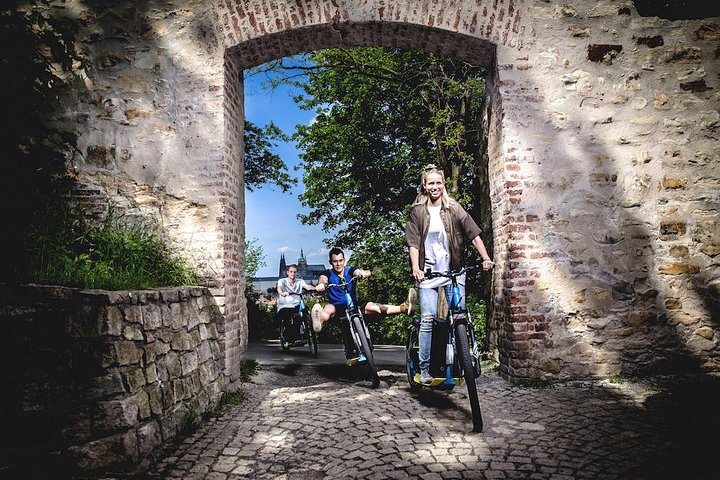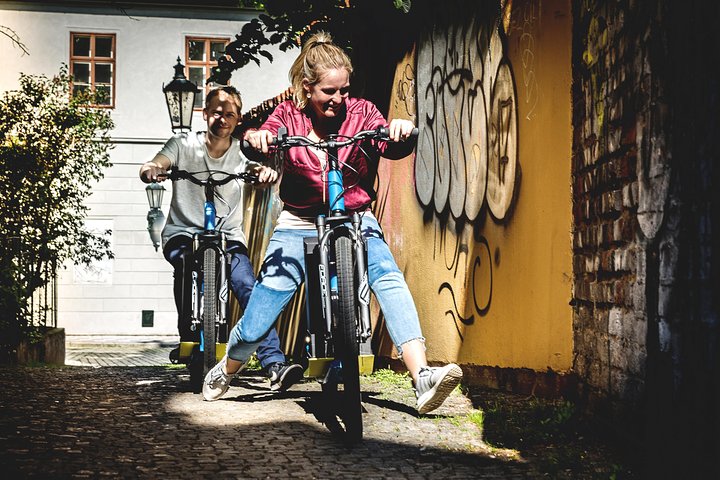1.5-Hour E-Scooter Tour In Prague ️with Best Panorama Views










E-scooters are the best way to learn, have fun and see plenty of Prague if you only stay for a limited time. Explore historical area surrounding Prague castle with local expert guide!
Get a benefit from long years of experience, whole team of local expert guides and luxury of the most exclusive starting point - right next to Charles bridge, in the heart of historical Prague. Along the unique route, you will see both major high-profile sights, but also get a chance to escape the biggest crowds and busy cobblestone streets.
This 1.5-hour tour aims to showcase charms of the so-called Lesser Town district. Discover the famous Lennon Wall, Kampa Park, Prague Castle, Petrin Tower & Park, Strahov Monastery, Loreto, Lesser Town, St. Nicolas Church, Letna Park and much more.
"Get the ticket, take the ride!"
Description
Itinerary
This is a typical itinerary for this product
Stop At: John Lennon Wall, Velkoprevorske namesti Mala Strana, Prague 11800 Czech Republic
In Kampa, not far from Charles Bridge, there is a wall painted all over with many colours. It symbolizes the tomb of the famous frontman of the legendary music band The Beatles, but it is also a place where people expressed their opinions and protested against the communist regime.
It is a colourful piece of a wall, covered with a thick layer of graffiti with a vivid history. Most colourful works of art are devoted to John Lennon and the lyrics by The Beatles.
After John Lennon was murdered, his fictitious tomb was created in Kampa. People started to paint symbols on the adjacent wall that resembled the artist’s life and especially his work. Even today the wall changes every day with new texts and pictures although they do not have much in common with the original idea, and thanks to lenient owners, the Order of Malta, everybody can leave their message there, but of course, the topic of love and peace is preferred.
Duration: 5 minutes
Stop At: Charles Bridge, Karluv Most, Prague 11000 Czech Republic
Charles Bridge is the oldest preserved bridge over the Vltava River in Prague and the second oldest preserved bridge in the Czech Republic. It was built in 1357 and the legend says that the foundation stone was laid on 9 July at 5.31 a.m. Thus, it is sequence 1-3-5-7-9-7-5-3-1. It was believed that thanks to that the bridge would stand forever. It is the fourth stone bridge construction in Bohemia. Due to the stone bridge Prague became an important stop on European trade routes. 30 baroque statues and sculptures were gradually placed on the bridge. The most famous among them is the statue of the Saint John of Nepomuk. Originally, the bridge was called just “Stone Bridge” or “Prague Bridge”.
Charles Bridge links the Old Town with the Lesser Quarter. It is formed by sixteen arches. There are three bends within its length and it is slightly convex up stream. It was founded on millstones that might have been supported with oak piles bases.
Duration: 5 minutes
Pass By: Kampa Park, Mala Strana, Prague 118 00 Czech Republic
Kampa is an island on the Vltava River in the Lesser Quarter, Prague, from which it is separated by a mill drain called Čertovka. Kampa Island was first mentioned in the foundation document of a church of the Johanites. The island received its today’s appearance by adjusting the terrain and the Čertovka streambed. The northern part of Kampa is built-up with houses and Charles Bridges goes over it, the southern part of the island is formed by a park. Kampa did not have a name for a long time or it was just called “The Island”. The name “Kampa” (Kampa Island) first appeared in the second half of the 18th century. There is no evidence of the origins of that name. The most probably theory says it was derived from the Latin word campus (field), as until the 16th century there were no houses on the island due to floods.
Stop At: Strahov Monastery, Strahovske Nadvori 1/132, Prague 11800 Czech Republic
Strahov Monastery, or in full the Royal Canonry of Premonstratensians at Strahov, is the oldest premonstratensian monastery in Bohemia, established in 1143, and one of the most important architectonic sights of the Czech Republic. The monastery, which was restored after 1990, also seats the Museum of National Literature, the famous Strahov Library and Strahov Gallery.
The Strahov Library is one of the most valuable and best preserved historical libraries not only in the Czech Republic. It maintains more than 200 thousand books, out of which over 3,000 manuscripts and 1,500 originals, saved in a special depository. The library consists of two halls, the Theological Hall and the larger Philosophical Hall, and the connecting corridor.
There is also the second oldest documented brewery in our territory.
Duration: 5 minutes
Pass By: Petrin Park, Petrinske sady 417/5, Prague 118 00 Czech Republic
Petřín is a hill in the centre of Prague, which is 327 metres high. On its top there is the Petřín Lookout Tower and many other buildings. “Petra” means “stone” in Latin, which is where the name Petřín was derived from. Stone – marlstone - was mined there for ages and was used for many constructions in Prague including the first churches in Prague Castle or the first bridge over the Vltava River. Petřín mines were first mentioned by Sázava Monk, who wrote that Abbot Silvester used Petřín stones to have the Sázava monastery church paved. In the course of centuries Petřín had several names: Petřín, the Mountain, the Hill, Saint Lawrence Hill, which name was derived from the patron saint of the church, who you can find on its hillside. Chronicler Kosmas described Petřín as a very rocky place.
Stop At: Petrin, Olympijska 3 6 Olympijska 3, Prague Czech Republic
Petřín Lookout Tower was built within the Anniversary Exhibition of 1891 as a free copy of the Eiffel Tower of Paris. Its foundations are 11 metres deep, it is 63.5 metres tall and weighs 175 tonnes. The core of the construction is formed by an octagonal tube, which includes a lift, and there are two spiral staircases with 299 steps – one is intended for going up and one for going down. The lookout tower has two lookout platforms, the lower one in the height of 20 metres, the upper one at 55 metres.
Besides the view of the skyline of Prague including the nearby Prague Castle, the lookout tower offers a distant view of Bohemia when the weather is clear. In the north you can see Říp Mountain and the Central Bohemian Uplands, in the north-east you can see the Giant Mountains massif. The view of the south-east is quite limited as it is closed by the Brdy Hills.
Duration: 5 minutes
Stop At: Prague Castle, Hradcany, Prague 11908 Czech Republic
A view of Prague Castle belongs to the most breathtaking panoramas. One of the largest castle compounds in the world consists of historic palaces, church buildings, gardens and picturesque recesses. Prague Castle has been a symbol of the Czech state for more than one thousand years. It was founded in the 9th century and became the seat of Czech kings and later presidents. According to the Guiness Book of Records, Prague Castle is the largest ancient castle in the world. The castle also includes St. Vitus Cathedral, a traditional place of coronation of Czech kings and the place where they were buried.
Duration: 5 minutes
Stop At: Letna Park, Praha 7, Prague 170 00 Czech Republic
The park in Letná is the second largest park in Prague 7. A public park was founded there at the second half of the 19th century according to the design by B. Wünscher and J. Braul. The name was derived from the word Leteň, which means “Sunny Hill”. Letná Park is the largest non-built-up green area in Prague, where people can spend their free time doing sport, taking a walk or having a picnic. Letná Park provides an enchanting view of the Vltava River and the city. Due to its strategic position the plain of Letná and its adjacent slopes always served as a gathering place and campsite of armies. It also hosted various celebrations, such as the coronation of Ottokar II of Bohemia. In 1950’s, however, people went to Letná to see the so-called “queue for meat” - a monument of the dictator J. V. Stalin, which, due to its height of 65 metres, was the second largest monument of this kind in Europe.
Duration: 5 minutes
Stop At: Franz Kafka Muzeum, Cihelna 2B Mala Strana, Prague 118 00 Czech Republic
Franz Kafka (3 July 1883 – 3 June 1924), sometimes also František Kafka, his Jewish name Anšel (אנשיל), was a German-writing Bohemian Jewish novelist. He is considered one of the most influential authors of the 20th century in terms of his work. He wrote three novels – Amerika (America), Der Process (The Trial) and Das Schloss (The Castle) – and a number of stories (e.g. die Verwandlung – The Metamorphosis).
He studied law and was employed as an insurance company clerk. He never got married. He was a non-smoker, an abstinent and a vegetarian. He fell ill with tuberculosis. Almost the entire life of his was connected with Prague.
Franz Kafka was born in the Old Town, Prague, as the eldest son of a Jewish haberdashery wholesaler Hermann Kafka and Julie Kafka. The author’s native house called U věže (By the Tower), which was situated in the corner of today’s Maiselova and U radnice streets, was later destroyed by fire. The current name of the adjacent square bears his name, too.
Duration: 5 minutes
Inclusions
- English speaking guide
- Audio guides available in German, Spanish, French, Italian and Russian
- Helmet
- Raincoat in case of rain
- Gloves in winter season
- Unlimited water and coffee at the meeting point
Exclusions
- Food and drinks during the tour
- Hotel pickup (available at additional cost)
- Hotel drop-off
Additional information
- Not wheelchair accessible
- Maximum is 9 people
- Light rain is no argument for cancelling the tour. In case of heavy rain you will be offered a full refund or reschedule.
- Please wear comfortable shoes and dress appropriately
- Children must be at least 150 cm to ride E-Scooter
- Pregnant women and persons over 120kg or under the influence of alcohol or drugs are not allowed to ride a E-Scooter
- please take an ID / passport with you
- Bicycle skills required
- Near public transportation
- Most travelers can participate
- Face masks required for guides in public areas
- Hand sanitizer available to travelers and staff
- Social distancing enforced throughout experience
- Regularly sanitized high-traffic areas
- Gear/equipment sanitized between use
- Transportation vehicles regularly sanitized
- Guides required to regularly wash hands
- Regular temperature checks for staff
- Contactless payments for gratuities and add-ons
- Post Covid-19, we’re compliant with current public health recommendations - avoid direct contact, maintain distance, use hand sanitizer.
- This tour/activity will have a maximum of 9 travelers
- Confirmation will be received at time of booking
Ticket delivery
You can present either a paper or an electronic voucher for this activity.
Operates
See Availability
Cancellation
For a full refund, cancel at least 24 hours in advance of the start time of the experience.
Culture Tours & Sightseeing Audio Guides Vespa, Scooter & Moped Tours Historical Tours
Checkout these other experiences on Plan Harmony
- Canyoning in Bled
- Premium Evening Desert Safari, Sandboard & BBQ Dinner
- Hanoi City Tour Full Day with Lunch
- Path of Gods Hike, with Food Experience at Shepherd's Hut
- Tour of a Vineyard, Winery & Cellar with Wine Tasting in Vouvray, Loire Valley
- Herzegovina Day Tour from Mostar: Blagaj, Pocitej, Kravice falls (Join Us! :D)
- Manatee Snorkel Tour with In-Water Divemaster/Photographer
- Northern Lights Big Bus Chase
- 2-Day Private Sightseeing Tour of Bali with Hotel Pickup
- Jumeirah Beach Parasailing Experience in Dubai